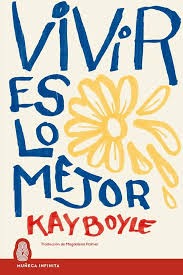
Original title: Life being the best. An anthology
Year of publication: Between 1931 and 1951
Translation: Magdalena Palmer
Valuation: Highly recommended
If a couple of years ago reading The blind horse represented the discovery of an author like Kay Boyle, reading this Living is the best It is confirmation of the quality of an author who seems to be slowly finding her space in the saturated Spanish market.
On this occasion, we find a collection of stories written between 1931 and 1951 that are presented in two differentiated parts according to thematic and chronological criteria.
The first of them (1931-1938) brings together nine stories with more or less common themes (racism, prejudices, madness, etc.) and which base a large part of their appeal on the gestures, silences and “gaps” that have been to fill out the reader. They stand out in this group:
- Living is the bestan initiation story with antagonistic characters that stands out for its powerful crescendo.
- Your idea of a mother, text of infinite sadness starring an orphaned child.
- Your body is a jewel box, dark story that begins with an image very much in the vein of The Baron Rampant to create a most uneasy atmosphere and, above all,
- Maiden, maiden, the best of the group for its development, associations, symbols and images, as well as for the interrelation of the interior and exterior landscape (and also, why not, for its setting, the Pasterze glacier, at the foot of the Grossglockner, which reminds me of a certain trip I took back in 2007).
The second (1941-1951), for its part, has the Second World War as its plot thread. But Boyle avoids the conflict itself and focuses on characters affected in one way or another by the war and the postwar period. Correspondents, peasants who suffer the hardships of the years after the conflict, German prisoners, abandoned children, etc., populate the pages of these stories that speak of anguish, misery, violence, longing for freedom, wounds and scars. These are much more explicit texts than the previous ones and this change in tone is somewhat shocking at first. I don’t know if it’s a coincidence or not, but it is precisely the last stories that are most interesting to me. So:
- The Fife House, a story that can be read as a metaphor for the rise of Nazism. Wow, as if it were The white ribbon by Haneke (could Horst be the boy in the film?).
- The lostalso an initiatory text that vaguely recalls A blow at the heart by Louis Malle (to continue with the cinematographic references) and whose protagonists are three kids who approach a shelter. Perhaps it is the story that offers the greatest development of the characters and that has a more novelistic treatment.
- Winter nightdeeply sad, with those wounds that do not close.
Therefore, a more than recommendable selection of fifteen of the stories published by Kay Boyle, an author whose texts (especially those in the first part) remind me of the much better known in these parts, Carson McCullers. Let’s see if with a little luck Boyle becomes as widespread as McCullers. I hope so.
Also from Kay Boyle in ULAD: The Blind Horse
Source: https://unlibroaldia.blogspot.com/2024/01/kay-boyle-vivir-es-lo-mejor.html


